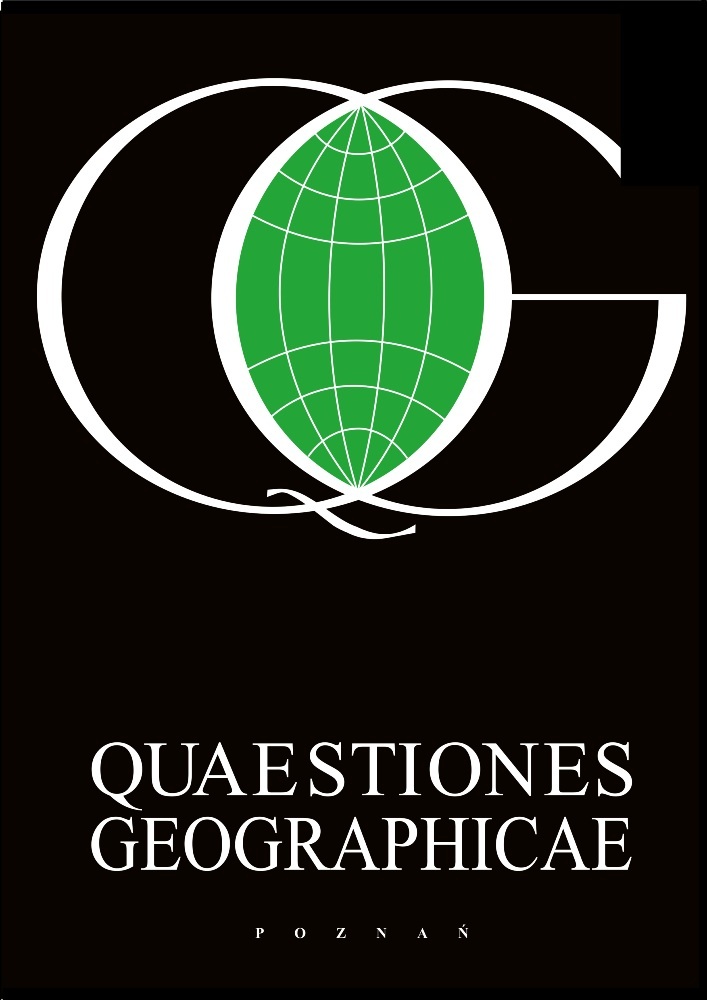Abstract
Entropy has been proposed as a significant tool for an analysis of spatial differences. Using Semple and Gauthier’s (1972) transformation of the Shannon entropy statistic into an entropy measure of inequality and their algorithm, an estimation is made of changes in regional inequality in Poland over the years 2005–2012. The inequality is decomposed into total, inter- and intra-regional types, and an analysis is made of relations holding between them.
References
Batty M., 1974. Spatial entropy. Geographical Analysis 8: 1–32.
Batty M., 1975. Urban density and entropy functions. Geographical Papers, 36. Department of Geography, University of Reading, England.
Batty M., 2010. Space, scale, and scaling in entropy maximizing. Geographical Analysis 42: 395–421.
Berry B.J.L., Schwind P.J., 1969. Information and entropy in migrant flows. Geographical Analysis 1: 5–14.
Chojnicki Z., Czyż T., 1976. Entropia jako miara koncentracji przemysłu (Entropy as a measure of the concentration of industry). Sprawozdania nr 91 za 1973 r., Poznańskie Towarzystwo Przyjaciół Nauk, Poznań: 61–63.
Czyż T., Hauke J., 2011. Evolution of regional disparities in Poland. Quaestiones Geographicae 30(2): 35–48.
Domański R., 2012. Ewolucyjna gospodarka przestrzenna (Evolutionary spatial management). Wydawnictwo Uniwersytetu Ekonomicznego w Poznaniu, Poznań.
Ezcurra R., 2007. Is income inequality harmful for regional growth? Evidence from the European Union. Urban Studies 44(10): 1953–1971.
Gauthier H.L., Semple R.K., 1974. Trends in regional inequalities in the Brazilian economy 1947–1966. In: Thoman R.S. (ed.), Methodology and case studies, vol. I. Proceedings of the Commission on Regional Aspects of Development of the IGU. Hayword, California, USA: 249–266.
Griffin J.M., Semple R.K., 1971. Spatial-temporal trends in industrial dispersion. Discussion Paper No. 23, Department of Geography, Ohio State University.
Griffith D.A., 1978. A spatially adjusted ANOVA model. Geographical Analysis 10: 296–301.
Griffith D.A., 2003. Spatial autocorrelation and spatial filtering: Gaining understanding through theory and scientific visualization. Springer, Berlin – New York.
Haynes K.E., Phillips F.Y., Mohrfeld J.W., 1980. The entropies: Some roots of ambiguity. Socio-Economic Planning Sciences 14: 137–145.
Horowitz I., 1970. Employment concentration in the Common Market: An entropy approach. Journal of the Royal Statistical Society 135(3), Series A: 463–479.
Kostrubiec B., 1972. Analiza zjawiska koncentracji w sieci osadniczej (Analysis of the phenomenon of concentration in a settlement network). Instytut Geografii PAN, Prace Geograficzne 93, Wrocław.
Kudrycka J., 2014. A convergence analysis of regional development in Poland. III Scientific Conference on Spatial Econometrics and Regional Economic Analysis, Lódź, June 9–10, 2014.
Li X., Claramunt C., 2006. A spatial entropy-based decision tree for classification of geographical information. Transactions in GIS 10: 451–467.
Medvedkov Y.V., 1966. The concept of entropy in settlement pattern analysis. Regional Science Association Papers XVII, Vienna Congress: 165–168.
Medvedkov Y.V., 1969. Entropy: An assessment of potentialities in geography. Session of the IGU Commission on Quantitative Methods, London.
Semple R.K., Wang L.H., 1971. A geographical analysis of changing redundancy in inter-urban transportation links. Geografiska Annaler 3, Series 53B: 1–5.
Semple R.K., Gauthier H.L. 1972. Spatial-temporal trends in income inequalities in Brazil. Geographical Analysis 2: 189–179.
Shannon C.E., 1948. A mathematical theory of communication. Bell System Technical Journal 27: 379–423, 623–656.
Werner P., Korcelli P., Kozubek E., 2014. Population potential as a modulator of land use changes in Poland’s metropolitan areas. Quaestiones Geographicae 33(2): 37–50.
Wędrowska E., 2010. Wykorzystanie entropii Shannona i jej uogólnień do badania rozkładu prawdopodobieństwa zmiennej losowej dyskretnej (Use of the Shannon entropy and its generalisations in a study of the probability distribution of a discrete random variable). Przegląd Statystyczny LVII (4): 39–53.
Wędrowska E., 2012. Miary entropii i dywergencji w analizie struktur (Measures of entropy and divergence in an analysis of structures). Wydawnictwo UWM, Olsztyn.
Wilson A.G., 1967. A statistical theory of spatial distribution models. Transport Research 1: 253–269.
Wilson A.G., 1970. Entropy in urban and regional modelling. Pion Press, London.
Wilson A.G., 2010. Entropy in urban and regional modelling: Retrospect and prospect. Geographical Analysis 42: 364–394.
License
© 2015 Faculty of Geographical and Geological Sciences, Adam Mickiewicz University.
This work is licensed under the Creative Commons Attribution-NonCommercial-NoDerivatives 3.0 License.
